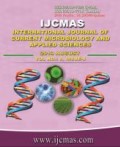


 National Academy of Agricultural Sciences (NAAS)
National Academy of Agricultural Sciences (NAAS)

|
PRINT ISSN : 2319-7692
Online ISSN : 2319-7706 Issues : 12 per year Publisher : Excellent Publishers Email : editorijcmas@gmail.com / submit@ijcmas.com Editor-in-chief: Dr.M.Prakash Index Copernicus ICV 2018: 95.39 NAAS RATING 2020: 5.38 |
Bihar lies in the river plains of the basin of the river Ganga. It is endowed with the fertile alluvial soil with abundant water resources. This makes the Agriculture of Bihar rich and diverse. The state has about 3.2 million ha under rice cultivation, which is mostly rainfed covering both uplands and shallow lowland ecosystems. The area has decreased from 36.57 to 32.22 lakh ha during the last six years. Rice is cultivated in 37 districts of Bihar. Out of 37 districts one district (Rohtas) having high productivity (above 25 quintal/ha) of rice, four districts namely Buxer, Bhabhua, Bhojpur and Patna comes under medium productivity (20- 25 quintal/ha) and rest 32 districts having less productivity (below 20 quintal/ ha), which accounts for 63% of 36.57 lakh hectares of total area under rice in the state. Area coverage under rice with high yielding varieties is about 65% and irrigation facility is available for about 40% rice area in the State. If the productivity of low productivity zone is increased, the rice production can be increased considerably without increasing the area under rice. Frontline demonstration (FLD) is an important tool for transfer of technology by the Krishi Vigyan Kendra. Keeping in view of an effective extension approach of FLDs for dissemination of improved cultivar of Rice, an impact assessment of FLDs conducted by KVK, Barh, Patna was conducted. The same also recorded grain yield 3652 kg/ha which is 23.08 % higher yield than local check (Komal). In spite of increase in yield with the use of improved technology, the technological gap, extension gap and technology index observed were848kg/ha, 685kg/ha and 885% respectively. The results improved technology in rice provided higher gross returns of Rs. 63225/ha with a benefit-cost ratio of 1.92 and additional net return of Rs. 29723/ha as compared to the local check. It could be recommended to replace the existing local HYV Komal with the improved rice variety RajendraSweta to adapt the existing farming situation with higher productivity and income.
 |
 |
 |
 |
 |